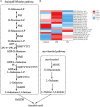Exogenous brassinolide improves the antioxidant capacity of Pinellia ternata by enhancing the enzymatic and nonenzymatic defense systems under non-stress conditions
- PMID: 35958199
- PMCID: PMC9358693
- DOI: 10.3389/fpls.2022.917301
Exogenous brassinolide improves the antioxidant capacity of Pinellia ternata by enhancing the enzymatic and nonenzymatic defense systems under non-stress conditions
Abstract
Brassinolide (BR) improves the antioxidant capacity of plants under various abiotic stresses. However, it is not clear about the effect of BR on the antioxidant capacity in plants under non-stress conditions. In the present study, the antioxidant defense response of Pinellia ternata was to be assessed by applying BR and propiconazole (Pcz) under non-stress conditions. BR treatment enhanced the flavonoid content, peroxidase, and ascorbate peroxidase (APX) activity by 12.31, 30.62, and 25.08% and led to an increase in 2-diphenyl-1-picrylhydrazyl (DPPH) radical scavenging activity by 4.31% and a decrease in malondialdehyde content by 1.04%. Exogenous application of BR improved the expression levels of PAL, CHS, CHI, and DFR genes by 3. 18-, 3. 39-, 2. 21-, and 0.87-fold in flavonoid biosynthesis, PGI, PMI, and GME genes by 6. 60-, 1437. 79-, and 3.11-fold in ascorbic acid (ASA), biosynthesis, and γECs and GSHS genes by 6.08- and 2.61-fold in glutathione (GSH) biosynthesis pathway, and the expression of these genes were inhibited by Pcz treatment. In addition, BR treatment promoted the ASA-GSH cycle by enhancing the expression of APX, DHAR, and MDHAR genes, which were enhanced by 3. 33-, 157. 85-, and 154.91-fold, respectively. These results provided novel insights into the effect of BR on the antioxidant capacity in bulbil of P. ternata under non-stress conditions and useful knowledge of applying BR to enhance the antioxidant capacity of plants.
Keywords: antioxidant enzyme; ascorbic acid; brassinolide; flavonoid; glutathione.
Copyright © 2022 Guo, Chen, Wang, Du, Wu, Chu and Yao.
Conflict of interest statement
The authors declare that the research was conducted in the absence of any commercial or financial relationships that could be construed as a potential conflict of interest.
Figures









Similar articles
-
Regulation Mechanism of Exogenous Brassinolide on Bulbil Formation and Development in Pinellia ternata.Front Plant Sci. 2022 Jan 5;12:809769. doi: 10.3389/fpls.2021.809769. eCollection 2021. Front Plant Sci. 2022. PMID: 35069668 Free PMC article.
-
Waterlogging faced by bulbil expansion improved the growth of Pinellia ternata and its effect reinforced by brassinolide.Plant Physiol Biochem. 2024 Feb;207:108377. doi: 10.1016/j.plaphy.2024.108377. Epub 2024 Jan 20. Plant Physiol Biochem. 2024. PMID: 38271862
-
Transcriptome Analysis Reveals an Essential Role of Exogenous Brassinolide on the Alkaloid Biosynthesis Pathway in Pinellia Ternata.Int J Mol Sci. 2022 Sep 17;23(18):10898. doi: 10.3390/ijms231810898. Int J Mol Sci. 2022. PMID: 36142812 Free PMC article.
-
Reactive oxygen species and antioxidant machinery in abiotic stress tolerance in crop plants.Plant Physiol Biochem. 2010 Dec;48(12):909-30. doi: 10.1016/j.plaphy.2010.08.016. Epub 2010 Sep 15. Plant Physiol Biochem. 2010. PMID: 20870416 Review.
-
Metal/metalloid stress tolerance in plants: role of ascorbate, its redox couple, and associated enzymes.Protoplasma. 2014 Nov;251(6):1265-83. doi: 10.1007/s00709-014-0636-x. Epub 2014 Mar 29. Protoplasma. 2014. PMID: 24682425 Review.
Cited by
-
Enhancement of wheat resistance to dry-hot wind stress during grain filling by 24-epibrassinolide: optimization of hormone balance and improvement of flag leaf photosynthetic performance.Front Plant Sci. 2025 Feb 24;16:1552617. doi: 10.3389/fpls.2025.1552617. eCollection 2025. Front Plant Sci. 2025. PMID: 40065789 Free PMC article.
-
Proper doses of brassinolide enhance somatic embryogenesis in different competent Korean pine cell lines during embryogenic callus differentiation.Front Plant Sci. 2024 Jan 23;15:1330103. doi: 10.3389/fpls.2024.1330103. eCollection 2024. Front Plant Sci. 2024. PMID: 38322821 Free PMC article.
-
Physiological Responses of Populus cathayana and Salix babylonica to Combined Stress of Diesel Fuel and Sr2+ Stress in Soil.Plants (Basel). 2024 Dec 23;13(24):3598. doi: 10.3390/plants13243598. Plants (Basel). 2024. PMID: 39771296 Free PMC article.
References
-
- Ahammed G. J., He B. B., Qian X. J., Zhou Y. H., Shi K., Zhou J., et al. (2017). 24-Epibrassinolide alleviates organic pollutants-retarded root elongation by promoting redox homeostasis and secondary metabolism in Cucumis sativus L. Environ. Pollut. 229 922–931. 10.1016/j.envpol.2017.07.076 - DOI - PubMed
-
- Badejo A. A., Eltelib H. A., Fukunaga K., Fujikawa Y., Esaka M. (2009). Increase in ascorbate content of transgenic tobacco plants overexpressing the acerola (Malpighia glabra) phosphomannomutase gene. Plant Cell Physiol. 50 423–428. - PubMed
LinkOut - more resources
Full Text Sources
Miscellaneous

